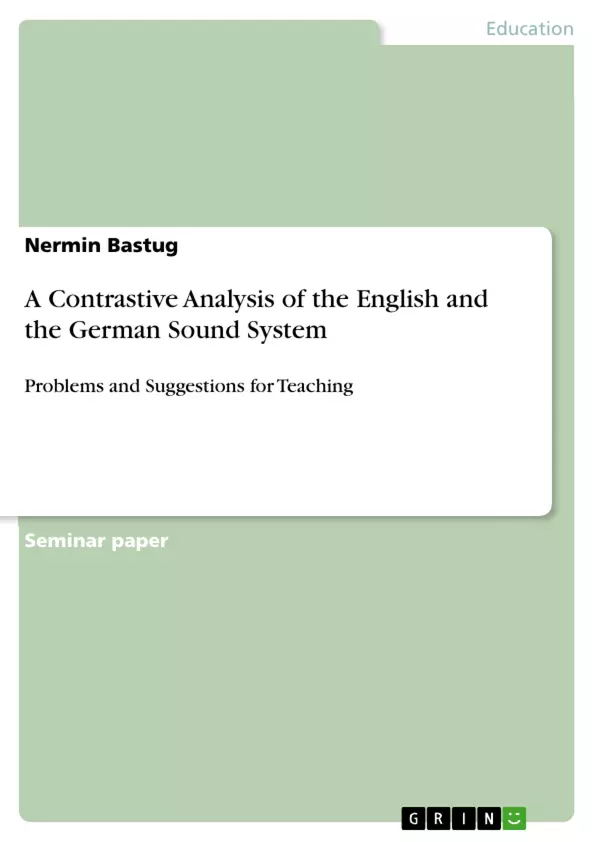This work is titled “A Contrastive Analysis of the English and the German Sound System. Problems and Suggestions for Teaching.”
The features of sound in a language are systematically structured. They are divided into two main branches:
(a) the branch of segmental features including consonants and vowels, and
(b) the branch of supra-segmental features including stress, intonation, pause, juncture, and rhythm
(Nasr 1997: 2).
My paper refers to branch (a) and illustrates the differences between the English (RP) and German consonant and vowel systems. The resulting contrasts reveal the main difficulties German learners of English are confronted with, therefore, these need to be exposed in teaching (Kufner 1971: 36).
After contrasting the sound systems, I will comment on the aim and importance of learning English pronunciation, and then I will explain the error degrees caused by the sound contrasts. Later, there is an overview of the most important qualifications of a phonetic teacher, and finally I will provide suggestions for teaching the pronunciation difficulties caused by the differences between the two languages.
Inhaltsverzeichnis (Table of Contents)
- Introduction.
- Contrastive Analysis
- The Consonants
- Phonemic Problems: /w/, /θ/, /ð/, /ʒ/, /dʒ/ ...
- Phonetic Problem: Clear and Dark /l/.
- Allophonic Problem: Aspiration of Word Final /p/, /t/, /k/..
- Distributional Problems
- Consonant Clusters.
- The Sounds /s/ and /ŋ, ŋg, ŋk/
- Final Devoicing
- The Vowels......
- Vowel Inventories - General Differences
- Front Vowels...
- Central Vowels..
- Back Vowels.
- The Consonants
- Teaching English Pronunciation
- Aim and Importance of Learning Pronunciation.
- Error Hierarchy...
- Qualifications of the Teacher.....
- Teaching Suggestions
- General Suggestions.......
- Suggestions for Teaching Particular Difficult Sounds........
- Conclusion..
Zielsetzung und Themenschwerpunkte (Objectives and Key Themes)
This paper analyzes the differences between the English (RP) and German consonant and vowel systems to identify the pronunciation difficulties encountered by German learners of English. It explores the importance of learning English pronunciation, discusses the error hierarchy arising from sound contrasts, and outlines the qualifications of a phonetic teacher. Finally, the paper offers suggestions for teaching the pronunciation difficulties caused by the differences between the two languages.
- Contrastive analysis of English and German sound systems
- Pronunciation difficulties for German learners of English
- Importance of learning English pronunciation
- Error hierarchy in English pronunciation for German learners
- Teaching suggestions for addressing pronunciation challenges
Zusammenfassung der Kapitel (Chapter Summaries)
The introduction establishes the scope of the paper, focusing on the segmental features of English and German sound systems. It highlights the significance of contrastive analysis in identifying pronunciation difficulties faced by German learners of English. The contrastive analysis section delves into the differences between the consonant systems of English and German, categorizing the difficulties into phonemic, phonetic, allophonic, and distributional problems. It provides detailed examples of the sounds that pose challenges to German learners, such as /w/, /θ/, /ð/, /ʒ/, /dʒ/, and the clear and dark /l/.
Schlüsselwörter (Keywords)
Contrastive analysis, English pronunciation, German learners, sound systems, phonemic problems, phonetic problems, allophonic problems, distributional problems, teaching suggestions, error hierarchy, qualifications of a phonetic teacher.
- Quote paper
- Nermin Bastug (Author), 2011, A Contrastive Analysis of the English and the German Sound System , Munich, GRIN Verlag, https://www.grin.com/document/195175



